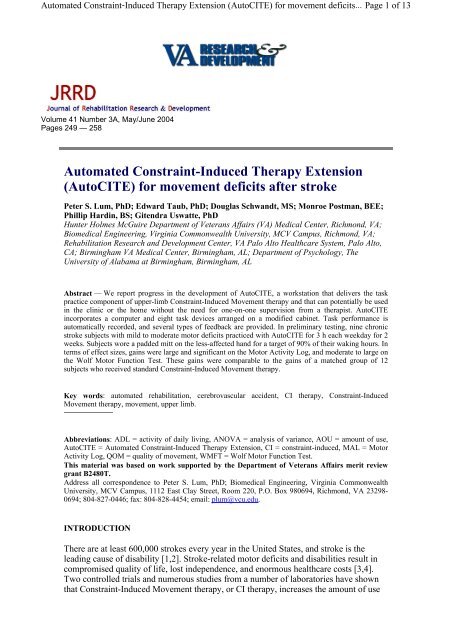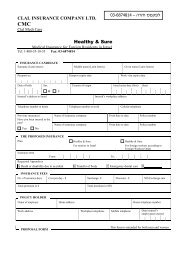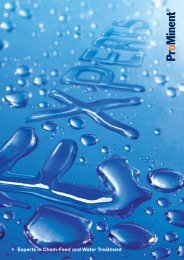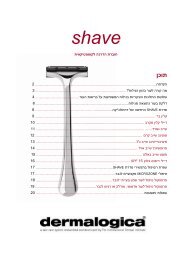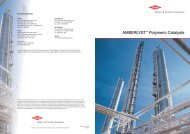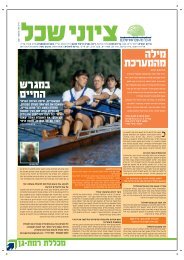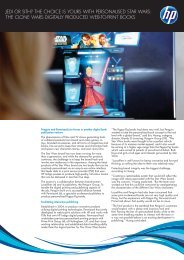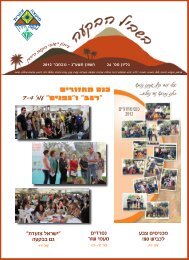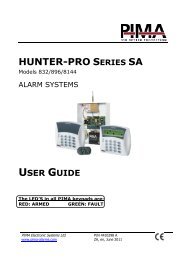Automated Constraint-Induced Therapy Extension (AutoCITE) for ...
Automated Constraint-Induced Therapy Extension (AutoCITE) for ...
Automated Constraint-Induced Therapy Extension (AutoCITE) for ...
Create successful ePaper yourself
Turn your PDF publications into a flip-book with our unique Google optimized e-Paper software.
<strong>Automated</strong> <strong>Constraint</strong>-<strong>Induced</strong> <strong>Therapy</strong> <strong>Extension</strong> (<strong>AutoCITE</strong>) <strong>for</strong> movement deficits... Page 1 of 13Volume 41 Number 3A, May/June 2004Pages 249 — 258<strong>Automated</strong> <strong>Constraint</strong>-<strong>Induced</strong> <strong>Therapy</strong> <strong>Extension</strong>(<strong>AutoCITE</strong>) <strong>for</strong> movement deficits after strokePeter S. Lum, PhD; Edward Taub, PhD; Douglas Schwandt, MS; Monroe Postman, BEE;Phillip Hardin, BS; Gitendra Uswatte, PhDHunter Holmes McGuire Department of Veterans Affairs (VA) Medical Center, Richmond, VA;Biomedical Engineering, Virginia Commonwealth University, MCV Campus, Richmond, VA;Rehabilitation Research and Development Center, VA Palo Alto Healthcare System, Palo Alto,CA; Birmingham VA Medical Center, Birmingham, AL; Department of Psychology, TheUniversity of Alabama at Birmingham, Birmingham, ALAbstract — We report progress in the development of <strong>AutoCITE</strong>, a workstation that delivers the taskpractice component of upper-limb <strong>Constraint</strong>-<strong>Induced</strong> Movement therapy and that can potentially be usedin the clinic or the home without the need <strong>for</strong> one-on-one supervision from a therapist. <strong>AutoCITE</strong>incorporates a computer and eight task devices arranged on a modified cabinet. Task per<strong>for</strong>mance isautomatically recorded, and several types of feedback are provided. In preliminary testing, nine chronicstroke subjects with mild to moderate motor deficits practiced with <strong>AutoCITE</strong> <strong>for</strong> 3 h each weekday <strong>for</strong> 2weeks. Subjects wore a padded mitt on the less-affected hand <strong>for</strong> a target of 90% of their waking hours. Interms of effect sizes, gains were large and significant on the Motor Activity Log, and moderate to large onthe Wolf Motor Function Test. These gains were comparable to the gains of a matched group of 12subjects who received standard <strong>Constraint</strong>-<strong>Induced</strong> Movement therapy.Key words: automated rehabilitation, cerebrovascular accident, CI therapy, <strong>Constraint</strong>-<strong>Induced</strong>Movement therapy, movement, upper limb.Abbreviations: ADL = activity of daily living, ANOVA = analysis of variance, AOU = amount of use,<strong>AutoCITE</strong> = <strong>Automated</strong> <strong>Constraint</strong>-<strong>Induced</strong> <strong>Therapy</strong> <strong>Extension</strong>, CI = constraint-induced, MAL = MotorActivity Log, QOM = quality of movement, WMFT = Wolf Motor Function Test.This material was based on work supported by the Department of Veterans Affairs merit reviewgrant B2480T.Address all correspondence to Peter S. Lum, PhD; Biomedical Engineering, Virginia CommonwealthUniversity, MCV Campus, 1112 East Clay Street, Room 220, P.O. Box 980694, Richmond, VA 23298-0694; 804-827-0446; fax: 804-828-4454; email: plum@vcu.edu.INTRODUCTIONThere are at least 600,000 strokes every year in the United States, and stroke is theleading cause of disability [1,2]. Stroke-related motor deficits and disabilities result incompromised quality of life, lost independence, and enormous healthcare costs [3,4].Two controlled trials and numerous studies from a number of laboratories have shownthat <strong>Constraint</strong>-<strong>Induced</strong> Movement therapy, or CI therapy, increases the amount of use
<strong>Automated</strong> <strong>Constraint</strong>-<strong>Induced</strong> <strong>Therapy</strong> <strong>Extension</strong> (<strong>AutoCITE</strong>) <strong>for</strong> movement deficits... Page 2 of 13of the more-affected upper limb in activities of daily living (ADLs) in patients with mildto moderately severe chronic stroke [5,6]. However, CI therapy is an intensiveintervention that involves a great deal of one-on-one therapist time and is there<strong>for</strong>e tooexpensive to be available <strong>for</strong> many individuals who would benefit from it. The aim ofour research was to determine if CI therapy could be automated, thereby reducing theneed <strong>for</strong> costly therapist time and consequently making the intervention available to alarger number of persons than is presently possible. This study is viewed as a first stepin developing a device that could administer CI therapy in the home; it would be a <strong>for</strong>mof "telerehabilitation," where contact with the therapist would be on a remote, periodic,and attenuated basis.CI therapy involves promoting use of the more-affected upper limb by restraining theless-affected limb <strong>for</strong> a target of 90 percent of waking hours <strong>for</strong> 2 to 3 consecutiveweeks (depending on the severity of the deficit) with a padded mitt that prevents use ofthe hand in ADLs. In its most common <strong>for</strong>m, the patients receive a type of trainingcalled "shaping" <strong>for</strong> 6 h per day (with rest intervals interspersed as needed) <strong>for</strong> allweekdays during the training period (concentrated training). Shaping is a widely usedbehavioral training technique in which a desired motor or behavioral objective isapproached in small steps, by successive approximations [7-11]. In many ways, shapingis a <strong>for</strong>malization and systematization of procedures already used by therapists whengiving patients task practice. Frequent explicit verbal feedback is provided <strong>for</strong> smallimprovements in per<strong>for</strong>mance, and per<strong>for</strong>mance regressions are ignored. A subset oftasks from a large bank of tasks is selected <strong>for</strong> each patient. All tasks are easilyquantifiable, so that small improvements are immediately apparent to both the patientand therapist.We report progress in the development of <strong>AutoCITE</strong> (<strong>Automated</strong> <strong>Constraint</strong>-<strong>Induced</strong><strong>Therapy</strong> <strong>Extension</strong>), a workstation that can potentially deliver the shaping trainingportion of CI therapy to patients without the need <strong>for</strong> one-on-one supervision from atherapist. This would substantially reduce the cost of CI therapy by allowing patients toper<strong>for</strong>m the exercises at home or by having one therapist treat four or more patientssimultaneously in the clinic. The reduced cost would greatly expand the pool ofindividuals who could receive the intervention. These advances in the delivery of CItherapy are significant, given the current healthcare climate of cost containment, wherethe provision of services by healthcare payers is being cut back sharply <strong>for</strong> inpatient andoutpatient physical rehabilitation therapy. <strong>AutoCITE</strong> would also provide clear andcomprehensive quantification of the progress of the treatment. This would indicate onwhich tasks the patient was progressing most and least rapidly, and enable rapid andeffective modifications of the treatment plan while treatment was in progress.The primary goal of this preliminary testing was to determine if interposing the<strong>AutoCITE</strong> between the subject and the therapist compromises the effectiveness of thetraining procedure. Three factors might diminish <strong>AutoCITE</strong>'s effectiveness relative tostandard one-on-one shaping with a therapist. First, in standard CI therapy, the therapistcan choose from a bank of well over 100 tasks, and can customize the tasks employed<strong>for</strong> each subject by creating new tasks that might be particularly useful or motivating. Incontrast, the <strong>AutoCITE</strong> currently only has 8 tasks implemented. Second, therapists haveconsiderably more flexibility in shaping a task relative to the shaping optionsimplemented in this version of the <strong>AutoCITE</strong>. Third, the patients must interact with acomputer, which could be less motivating than receiving one-on-one attention from atherapist. We had the therapist present during all the training sessions in this preliminarystudy in order to ensure the smooth functioning of this new procedure. However, thesessions were arranged so that the therapist supervised the interactions between thesubject and <strong>AutoCITE</strong> instead of administering the training directly. For example,
<strong>Automated</strong> <strong>Constraint</strong>-<strong>Induced</strong> <strong>Therapy</strong> <strong>Extension</strong> (<strong>AutoCITE</strong>) <strong>for</strong> movement deficits... Page 3 of 13instructions and encouragement <strong>for</strong> the subject were issued predominantly by thecomputer, with the therapist interjecting comments occasionally to supply additionalencouragement, or if the subject became confused or could not understand theinstructions.The specific question addressed in this study was whether a group of stroke subjectsgiven CI therapy by means of <strong>AutoCITE</strong> would achieve as large a treatment effect as agroup of subjects who received CI therapy in a nonautomated setting. Both groups wereequivalent in all significant demographic characteristics and had similar initial upperlimbmotor deficit. The long-term objective of our work is to develop a workstation thatcan be operated entirely by the subject, without a therapist overseeing the session.METHODS<strong>AutoCITE</strong> WorkstationIn the present setup, a computer provides simple one-step instructions on a monitor thatguides the subject through the entire treatment session (Figure 1). Sensors built into theworkstation verify completion of each instruction be<strong>for</strong>e the next instruction is given.Since hand function will be compromised initially in all subjects and the less-impairedhand will be in a mitt, the workstation is designed to be operated with gross movementsat each of the joints. A rotating arm is attached to the subject's chair and is swung infront of the subject during the session. The rotating arm has two pushbuttons that areused by the subject when a choice is to be made and to allow the subject to control theflow of the session by in<strong>for</strong>ming the computer that he/she is ready to move to the nextstep. Data are collected by a computer that is equipped with a digital input/output PCcard (PC-DIO-96, National Instruments, Austin, TX), and an encoder reader PC card(PC7166, US Digital Corp., Vancouver, WA). All software was custom-written in the Cprogramming language.Currently, eight tasks have been automated. Each task device was custom-manufacturedand uses simple and inexpensive means to record per<strong>for</strong>mance during the exercise. The
<strong>Automated</strong> <strong>Constraint</strong>-<strong>Induced</strong> <strong>Therapy</strong> <strong>Extension</strong> (<strong>AutoCITE</strong>) <strong>for</strong> movement deficits... Page 4 of 13activities are based on tasks currently used in CI therapy and collectively addressshoulder, elbow, hand, and wrist function. The eight task devices are arrayed in acabinet on four tiered work surfaces, whose height is automatically adjusted when a taskis selected to be worked on. Each work surface can be manually pulled out like a drawerand locked over the subject's lap. Two tasks are located on each work surface. The topwork surface can be pulled out and locked in three positions, allowing adjustment of thedistance from the subject to the device. Switches detect the position of each worksurface. Subjects sit in a customized chair that can be moved to different distances fromthe table and locked into place, depending on the arm length of the subject. The chaircan also rotate and be locked at several angles. A digital shaft encoder (E2 Optical KitEncoder, US Digital Corp.) measures the angle of the chair, and a limit switch detectsthe flex of the chair as the subject leans back against the seat. Data from the latter sensorare used by the computer program to sound a buzzer when subjects are leaning <strong>for</strong>wardduring task practice. A computer monitor with a touch screen (Entuitive 1725C, EloTouchSystems, Fremont, CA) is located on the top shelf and has multiple functions:display of the menu <strong>for</strong> task selection, provision of various types of per<strong>for</strong>mancefeedback, display of instructions <strong>for</strong> the subject to set up and per<strong>for</strong>m each task, anddisplay and interface <strong>for</strong> two tasks that involve the touch screen directly. The constraintsof the apparatus require that the task be per<strong>for</strong>med correctly, within limits, anddeviations from prescribed per<strong>for</strong>mance are recorded.At the beginning of each session, all work surfaces are pushed all the way in. Thesubject uses the buttons on the rotating arm to select a task from the menu displayed onthe computer monitor. The computer program controls a motorized linear actuator(Desklift DL1, Linak Inc., Louisville, KY) that automatically moves the workstation upor down, stopping when the appropriate work surface is positioned at lap level. Thesubject then pulls the work surface out, locks it in place, and begins the task. Thecomputer program guides the subject through a set of ten 30 s trials with the selectedtask. The subject is instructed to repeat a task as many times as possible within each 30 strial interval. Final feedback <strong>for</strong> that task is presented and the task menu is thendisplayed, making it possible <strong>for</strong> the subject to select the next task.Several types of per<strong>for</strong>mance feedback are provided. The time remaining on each trial isshown to the subject on the computer monitor by a circular display whose filled areaprogressively increases along a moving radius line as time elapses. The computerproduces an audible beep when a repetition is completed. The number of repetitions ofthe required task movement is displayed to the subject after each trial in the <strong>for</strong>m of anew bar on a graph containing a bar <strong>for</strong> each trial in that set (Figure 2). The height ofthe bars is proportional to the number of repetitions of the task in each trial; in addition,the number of repetitions is displayed as an Arabic numeral above each bar. Ahorizontal red line across the bar graph indicates the best previous single trialper<strong>for</strong>mance <strong>for</strong> that task, while a horizontal blue line indicates the mean per<strong>for</strong>manceof the previous set of 10 trials. Our observation was that the subjects tended to pay moreattention and receive more per<strong>for</strong>mance motivation from the end-of-trial display thanfrom the within-trial elapsed time indicator. Encouraging comments, such as "Wow,""That's a new record," or "Keep up the good work," are provided by the computer whena new best per<strong>for</strong>mance is attained <strong>for</strong> all trials of that task. Two other sets of commentsare used to encourage subjects if per<strong>for</strong>mance is well below average (e.g., "Let's keeptrying," "Ready <strong>for</strong> another try") or if per<strong>for</strong>mance is not a new best, but is better thanthe average on the previous set (e.g., "Well done," "Good work"). Data are collected at250 Hz and stored <strong>for</strong> later examination.
<strong>Automated</strong> <strong>Constraint</strong>-<strong>Induced</strong> <strong>Therapy</strong> <strong>Extension</strong> (<strong>AutoCITE</strong>) <strong>for</strong> movement deficits... Page 5 of 13While the goal was to have the subjects operate the workstation without physicalassistance from the therapist, one aspect of the workstation, related to changing fromone task to another, could not be easily per<strong>for</strong>med by some subjects with their moreaffectedlimb in this prototype device; locking, unlocking, and pulling out the worksurfaces required more arm function than most of the subjects possessed and wasthere<strong>for</strong>e carried out by the therapist. Also, it was found that the increments in thepositions of the top work surface were too large to be used as a shaping parameter <strong>for</strong>the reaching and tracing tasks. There<strong>for</strong>e, in order to increase the distance of the monitorfrom the subject, the therapist positioned it manually in inch increments. The weight ofthe monitor prevented any movement of the work surface resulting from contact withthe touch screen during task per<strong>for</strong>mance. However, all subjects carried out all otheraspects of task setup without assistance from the therapist.During testing with the device, the therapist supervised the session by operating thekeyboard of the computer and providing verbal encouragement to the subject whenneeded. He could bring up a special display screen that presented the subject'sper<strong>for</strong>mance from all trials of a particular task since the beginning of the 2-weektreatment. The therapist also used the keyboard to modify the difficulty of each taskusing the principles of CI therapy shaping. A brief description of each task follows(Figure 3).
<strong>Automated</strong> <strong>Constraint</strong>-<strong>Induced</strong> <strong>Therapy</strong> <strong>Extension</strong> (<strong>AutoCITE</strong>) <strong>for</strong> movement deficits... Page 6 of 13ReachingThis task involves successive tapping of a button positioned on the rotating arm just infront of the body and a target circle located on the touch screen monitor. When the touchscreen is touched, a conductive coating on a transparent cover sheet makes electricalcontact with a conductive coating on the glass of the monitor. This produces voltagesthat are analog representations of the position touched. This position in<strong>for</strong>mation istransmitted by the touch screen controller to the computer via a serial port connection.Feedback consists of an audible beep when the target is touched and by filling in thetarget circle on the monitor. Per<strong>for</strong>mance is measured as the number of completedcycles, and task difficulty can be increased by moving the monitor further away orhigher, decreasing the size of the target, or rotating the chair of the subject so that thetarget is located more laterally.Peg BoardThe task is to move three pegs from a row of holes to a mirror-image row of same-sizedholes on the other side of the board and then back again, etc. Each peg has a magnetembedded in its base. Reed switches in the holes measure when a peg is in place. Thesereed switches are normally open, and they close when a magnetic field is close by.Three sizes of pegs are used with a row of corresponding sized holes on either side ofthe board. The tallest and largest diameter pegs (11.6 × 3.7 cm) require cylindrical grasp<strong>for</strong> prehension, the intermediate size (7.2 × 2.0 cm) require three-jaw-chuck grasp, andthe smallest cylinders (3.4 × 0.6 cm) require thumb-index finger pinch. Per<strong>for</strong>mance ismeasured as the number of pegs moved in 30 s.Supination/PronationSubjects grasp a cylindrical handle that is mounted to a shaft and bearing assembly thatallows rotation about an axis through the <strong>for</strong>earm. A digital shaft encoder measures theposition of the handle, and an electromagnetic brake on the shaft coupled to the encodersimulates mechanical stops by engaging when a particular angle is exceeded in eachdirection. Subjects rotate the handle back and <strong>for</strong>th between these two stops.
<strong>Automated</strong> <strong>Constraint</strong>-<strong>Induced</strong> <strong>Therapy</strong> <strong>Extension</strong> (<strong>AutoCITE</strong>) <strong>for</strong> movement defic...Page 10 of 13Participants from both <strong>AutoCITE</strong> and standard CI therapy groups showed very largeimprovements in real-world arm function as measured by the MAL, and moderate tolarge improvements in arm motor ability as measured by the WMFT. On the MAL,participants from both groups combined showed on average a 2.2 (0.4) point increase in


